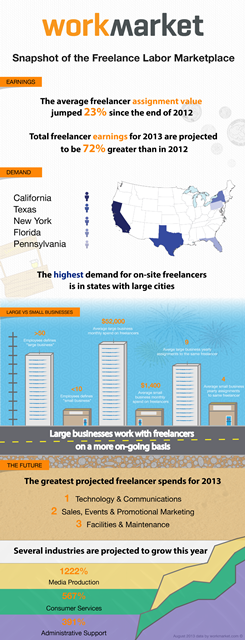 Our friends Jeff Leventhal and Co. at NYC-based Work Market today announced the results of a study on the freelance economy, which is good news for freelancers and self-employed individuals working in the U.S. Based upon data from Work Market’s online marketplace and enterprise management platform, demand for freelancers and wages earned are expected to increase through the end of this year.
Our friends Jeff Leventhal and Co. at NYC-based Work Market today announced the results of a study on the freelance economy, which is good news for freelancers and self-employed individuals working in the U.S. Based upon data from Work Market’s online marketplace and enterprise management platform, demand for freelancers and wages earned are expected to increase through the end of this year.
The Work Market study also revealed that businesses with more than 50 employees offer a greater opportunity for ongoing work than those with less than 10 employees.
Businesses of all sizes are increasingly using freelancers as part of their workforce, and businesses with more than 50 employees use the same freelancer for an average of nine jobs per year. Conversely, businesses with less than10 employees use the same freelancer for approximately four jobs per year. Thus, larger companies provide freelancers with a greater opportunity to find ongoing work.
Interestingly, but not surprisingly, technology and communications companies are using more freelancers than any other industry. The top three industries using freelancers and their associated spend are: Technology/Communication, Sales/Event/Promotional Marketing, and Facilities and Maintenance.
Work Market also predicts that media production will increase spending on freelancers (which is good for us here at SMB Nation), and spending on contract labor is set to increase across various industries throughout the end of this year.
Total freelancer earnings for 2013 are projected to be 72 percent greater than in 2012, with the greatest projected spending on freelancers in the areas of Media Production, 1222%; Consumer Services, 567%; and Administrative Support, 391%.


